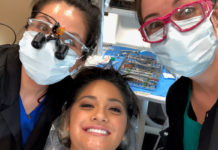
REIGNITE YOUR PASSION FOR DENTISTRY BY CHANGING YOUR PHILOSOPHY.
Three years ago, when I started my practice, I was struggling with the rigors of both personal and professional obligations. My wife and I had a new baby who, of course, took up a great amount of personal time. Professionally, I soon discovered that starting my own dental practice wasn’t as easy as I imagined it would be when I was in dental school. I was struggling with finding my passion. In fact, I probably hadn’t used the words “passion” and “dentistry” in the same sentence prior to my first course with Dr. Jim Downs.
It was during this time of frustration that my brother suggested I consider taking some dental courses that might enhance my practice. I figured, “Hey, what do I have to lose?” At the very least, if I didn’t learn anything to help my practice, maybe someone at the course would want to purchase my practice and I could just move on. At that time, either scenario was a win-win for me. In April 2011, I signed up for the Over the Shoulder: Full Arch Reconstruction (FAR) course taught by Dr. Jim Downs at Arrowhead Dental Lab. At the time, full arch dentistry couldn’t have been further off my radar. I was mostly concerned with staying on top of my crazy workload—not in learning how to do any cosmetic procedures. However, that mindset definitely changed over the next few days.
At the beginning of the course, I was introduced to the “Why” of full arch dentistry. I learned that in order to achieve what is desired in full arch dentistry, one must possess a guiding philosophy. I had to expect the best of myself and be teachable enough to achieve it. I also learned that excellent results require an obsessive interest in the patient. If I accepted a case, then I needed to do it with the patient’s well being at the forefront of my mind. I had to literally make a paradigm shift from working on the patient to working for the patient. It has always been my nature to be kind to people, but this idea of connecting that guiding principle to my dental practice was truly career changing.
The course’s introduction to the “How” of cosmetic dentistry was just as beneficial as the “Why.” The technique portion of the course included in-depth instruction on the concepts of comprehensive dentistry and how they can be properly applied. We studied bur selection and ergonomics, final impressions, diagnostic records, and shrink-wrap temporaries (for the latter, I’ve never seen temporization in the same light since). Throughout the over-the-shoulder procedures, Dr. Downs demonstrated the system that he uses to simplify each layer of the process to achieve consistent quality and long-term predictability. We talked through Dr. Downs’s concept of “Swords of Technology” and why he advocates for electric handpieces, CO2 lasers and Tekscan® occlusal sensors. Dr. Downs’s mastery of this procedure was well established by the “prep-day,” but watching him prep, impress and temporize a full arch while 20 doctors crowded in and peppered him with questions, definitely sealed the deal for me.
By the end of the course, I was convinced of the system, the technology, and the lab’s ability to deliver. My mind made a dramatic shift throughout those few short days. It reignited my passion for dentistry, focused the direction of my practice, and refined my philosophy for treatment. When I returned to my rural eastern Oklahoma practice, I found that the philosophies outlined in the course were well-applied to every aspect of dentistry and dental practice. I can confidently tell all dentists (even if they never intend to do full arch dentistry), that they will benefit from taking the courses. I improved in all aspects of my dentistry and the experiences truly helped me take the “next steps” in my professional development. I can’t point to any one detail that changed how I practice, but I can tell you that surrounding yourself with a group of professionals focused on excellence and concerned with delivering quality dentistry will make you better at a difficult and sometimes trying profession.
As of October 2013, I have finished my most complex and comprehensive full arch reconstruction case to date (see case study, on next page). As with all big cases, there have been revisions, but they are easily handled because I want what is absolutely best for my patient. So if something must be redone, or if we must change the treatment plan to account for something, it’s no big deal and there’s no interpersonal stress between me and my patient. I have a lot to give to my patients because I work from a place of abundance of care and concern—a philosophy I obtained from my first full arch course that remains with me today.
CASE STUDY: A FULL ARCH RESTORATION
 The patient’s chief complaint was that a veneer “popped off.” The initial exam revealed 6 to 11 labial veneers and a Shimbashi measurement of -3. Placed in 2007, the veneers began failing as the bonding suffered under the load of the extreme overbite they created, coupled with parafunction she developed due to her mandible being trapped and her social anxiety. As the bonding failed and some of her veneers came off, the patient developed a habit of protruding her jaw to check for looseness in her restorations, as she was worried that she might lose a veneer in a social situation.The cyclic lever forces app lied to the incisal edge of the veneers acted to speed their demise.
The patient’s chief complaint was that a veneer “popped off.” The initial exam revealed 6 to 11 labial veneers and a Shimbashi measurement of -3. Placed in 2007, the veneers began failing as the bonding suffered under the load of the extreme overbite they created, coupled with parafunction she developed due to her mandible being trapped and her social anxiety. As the bonding failed and some of her veneers came off, the patient developed a habit of protruding her jaw to check for looseness in her restorations, as she was worried that she might lose a veneer in a social situation.The cyclic lever forces app lied to the incisal edge of the veneers acted to speed their demise.
On the prep day, we started by removing all of her old dentistry.Removal of base metal PFM scan be difficult and costly. An electric hand-piece malfunctioned during the sectioning of the 2 to 5 bridge. Upon removal of the bridge, we discovered that tooth numb er 5 required endo,post, and core placement. We adapted the treatment plan to the conditions presented and proceeded. Fortunately, tooth number 5 was our only surprise that day and everything else went smoothly.
Later, we placed implants in the 19 and 20 sites to complete her arch form and to improve her occlusal scheme. Preparing two arches in a single day is challenging, but possible. The prep guide provided with the case work-up was invaluable and helped to quickly identify where to focus our attention. I highly recommend sticking with the outlined system and focusing on the progression, and before you know it, you will be prepping the last three teeth! Throughout the course of treatment, the patient continued to “check her veneers.” Ultimately it resulted in a fracture on the prepared teeth at the gingiva after the finished case returned from the laboratory. It was a frustrating moment, but also it provided an opportunity. As we discussed options and the timetable for repair, I reiterated the importance of the appliance and her compliance. We were able to seat the rest of her restorations and perform the work to finish the case. We planned to restore her implants after seating the case, so we took an impression and had the anterior teeth fabricated with the implant restorations. In the end, the fracture turned out to be a minor setback.
After seeing her new smile, the patient’s response was, “This is way more than I expected!” And when I asked, “What do you mean?” she said, “Well I’ve seen a lot of my friends who have had their teeth done and their teeth all appeared to be very uniform and white. But my teeth had a shading of color like natural teeth and you could see through them like natural teeth.” She continued, “I didn’t know there was a way for you to make them look so natural!” I responded, “Well you’re used to looking at a porcelain-fused-to-metal crown, which is an older technology and we’re using the latest technology which is a lithium disilicate crown.We’re also using an Elite technician who has the ability to make all of the artistic nuances that make a stain look natural.” I couldn’t have asked for a more positive reaction.
Going forward, I am confident that I can present these cases and that I now have the ability to say “yes” to big treatments and deliver quality for my patients. With the success of this latest case, I have a “walking billboard” advertising my services. Her smile tells everyone, “Look what he did for me!” My perspective has completely changed—from “I can’t” to “I can” and from“I don’t” to “I do.” And it just keeps getting better!









